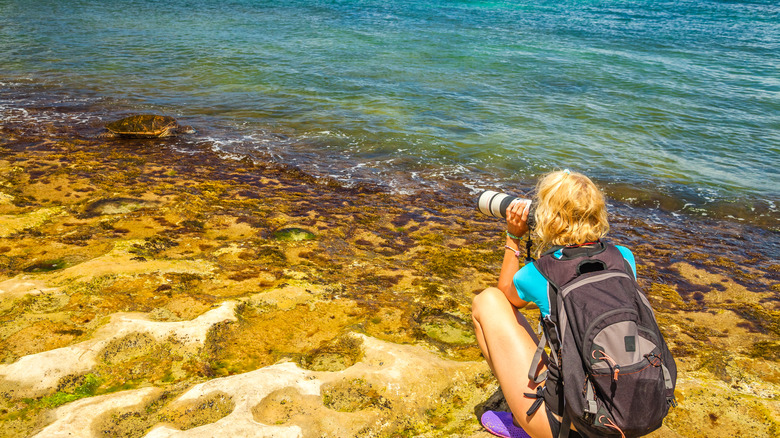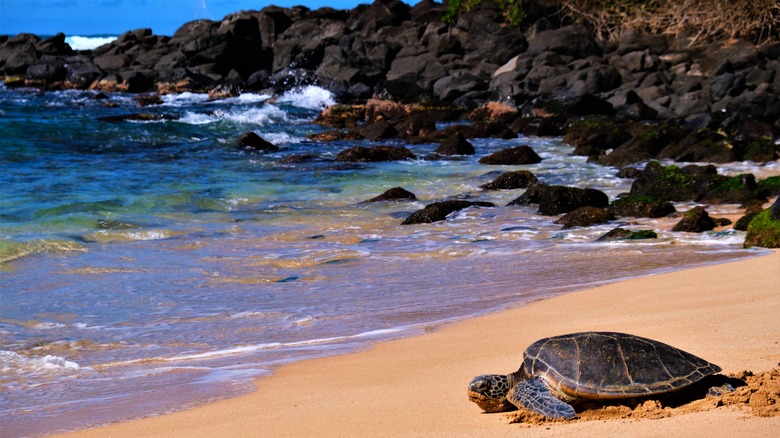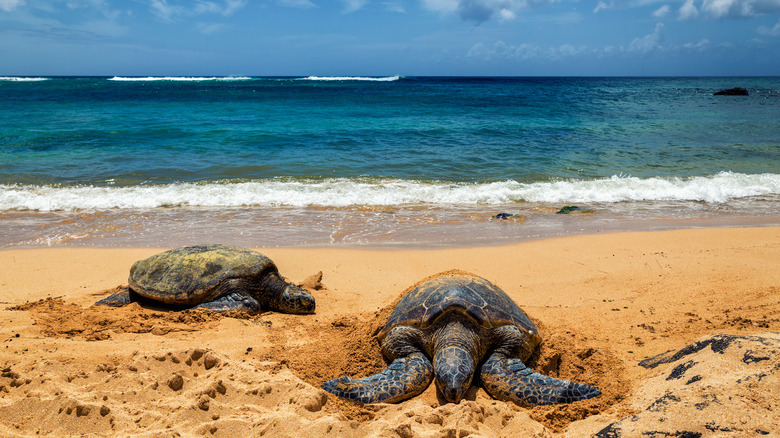Laniakea Beach, translating to “wide sky” in Hawaiian, nestles on the North Shore of Oahuor. It is affectionately known as Turtle Beach, offering a unique spectacle that draws both locals and tourists alike — the chance to witness sea turtles in their natural habitat. Renowned for its frequent visits of Hawaiian sea turtles, Laniakea Beach is a stunning seascape and, more importantly, a pivotal site for turtle observation and conservation in Hawaii.
Laniakea Beach is unique for its almost guaranteed turtle sightings. Five types of sea turtles call Hawaiian waters their home: green, hawksbill, leatherback, loggerhead, and olive ridley. The most frequent visitors are the wild Hawaiian green sea turtles, known locally as honu. These majestic creatures are often seen swimming gracefully near the shore or basking on the beach. They come ashore primarily to rest, making Laniakea Beach one of the few places in the world where visitors can easily observe sea turtles in their natural environment.
Green sea turtles can live up to 70 years or more in the wild. They are one of the largest species of sea turtles, with adults typically weighing between 250 and 400 pounds and measuring between 3 and 4 feet in length. Females return to the same beach where they were born to lay their eggs — they can lay over 100 or more eggs in a single nest or multiple nests and only do so every 2 to 5 years. However, only one out of 1,000 hatchlings survives.
Sea turtles at Laniakea Beach

The presence of honu at Laniakea Beach is a testament to the success of local conservation efforts. Sea turtles are listed as a threatened species under the U.S. Endangered Species Act. Their populations have faced significant threats from habitat loss, pollution, accidental entanglement in bycatch and marine debris, vessel strikes, and illegal hunting. Protection and monitoring efforts by local organizations and volunteers have been crucial in providing these animals with a much-needed sanctuary.
Timing your visit is key to maximizing your chances of seeing turtles at Laniakea Beach. Turtles are most commonly found on the beach during the sunniest part of the day, from late morning to early afternoon — 11:00 a.m. to 3:00 p.m. Turtles also tend to come ashore when the waters are calm, usually during the summertime in Hawaii. This is when they come ashore to warm themselves and take a break from the ocean currents.
When visiting Laniakea Beach, it’s important to remember that while the honu are accustomed to human presence, they are still wild animals and must be treated with respect. Observers must keep a distance of at least 10 feet — bring cameras and binoculars to merge the distance. Because sea turtles are legally protected in Hawaii, touching them is a federal crime that can get you fined up to $10,500 (per HRS Chapter 195D and HAR 13-124). Since this strict but necessary law was enacted, turtle populations in Hawaii have grown significantly.
Tips for your visit

The shore at Turtle Beach has many volcanic rocks scattered throughout the water. These rocks are crucial in attracting sea turtles as algae, moss, and other marine vegetation grow on them. This vegetarian diet gives sea turtles their cartilage and fat a greenish color, which is how they get their name. Although it might be tempting to wade into the waters to get a closer look at the ancient mariners, swimming here is dangerous and not recommended. The rocky beach opens to the ocean and lacks lifeguard supervision, so bring protective water shoes if you plan to step in. Otherwise, the nearby Chun’s Reef offers a sandy beach and a safer swimming experience.
Turtle Beach is located a mile outside Haleiwa Town, just under an hour’s drive from Waikiki. A small designated parking lot is across the street. The beach is very natural and doesn’t have any facilities like restrooms, showers, or picnic tables — bring your own necessities and leave no trace. Visitors can contribute to conservation efforts by adhering to guidelines set by wildlife authorities. They can also participate in local clean-up events and support organizations such as Malama na Honu and the Hawaiʻi Wildlife Fund (you can even volunteer or intern with them!). Whether you are a nature lover, photography enthusiast, or simply looking for a peaceful place to unwind, Laniakea Beach is one of the best destinations to experience sea turtles up close.

